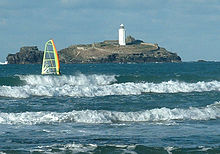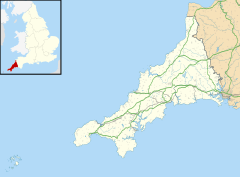Godrevy Lighthouse
 |
|
|
Cornwall
|
|
| Location | Near St. Ives Cornwall England |
|---|---|
| Coordinates | 50°14′33″N 5°24′1″W / 50.24250°N 5.40028°WCoordinates: 50°14′33″N 5°24′1″W / 50.24250°N 5.40028°W |
| Year first constructed | 1 March 1859 (first) |
| Year first lit | 2012 (current) |
| Automated | 9 August 1939 |
| Deactivated | 2012 (first) |
| Construction | rubble, stone and mortar |
| Tower shape | octagonal tower with balcony and lantern |
| Markings / pattern | white tower and lantern |
| Height | 26 m (85 ft) (first) |
| Focal height | 37 m (121 ft) (first) 28 metres (92 ft) (current) |
| Original lens | 2nd Order 700 MM Fixed Optic With Red Sector |
| Current lens | 2 x marine LED sector lights |
| Intensity | white: 4,370 candela (first) red: 817 candela (first) 495 candela (current) |
| Range | white 12 nmi (22 km) (first) red 8 nmi (15 km) (first) 8 nmi (15 km) (current) |
| Characteristic | Fl WR 10s. |
| Admiralty number | ex-A5654 |
| NGA number | ex-6284 |
| ARLHS number | ENG 047 |
| Managing agent | Hall for Cornwall |
Godrevy Lighthouse was built in 1858–1859 on Godrevy Island in St Ives Bay, Cornwall. Standing approximately 300 metres (980 ft) off Godrevy Head, it marks the Stones reef, which has been a hazard to shipping for centuries.
The Stones claimed many ships, prompting calls for a lighthouse to be built, but nothing came of plans until the wreck of the iron screw steamer SS Nile during a storm on 30 November 1854. All of her passengers and crew, numbering about 40 people in total, were lost.
The disaster prompted fresh calls for a light to be built. Richard Short, a St Ives master mariner, wrote to the Shipping and Mercantile Gazette the day after the news of the sinking broke to note: "[H]ad there been a light on Godrevy Island, which the inhabitants of this town have often applied for, it would not doubt have been the means of warning the ill-fated ship of the dangerous rocks she was approaching. Many applications have been made from time to time concerning the erection of a light to warn mariners against this dangerous reef, but it has never been attended to, and to that account may be attributed the destruction of hundreds of lives and a mass of property ... Scarcely a month passes by in the winter season without some vessel striking on these rocks, and hundreds of poor fellows have perished there in dark dreary nights without one being left to tell the tale."
Further though less lethal accidents followed, prompting a local clergyman, the Rev. J.W. Murray of Hayle, to start a petition to Trinity House to build a lighthouse on the island. The petitioners were informed in October 1856 that Trinity House had agreed to build the Godrevy Lighthouse. By December 1857, James Sutcliffe had been appointed as the engineer for the project, with James Walker contracted to design the lighthouse. Its construction took around a year at a cost of £7,082 15s 12d and the light began operating on 1 March 1859.
The lighthouse is a white octagonal tower, 86 feet (26 m) high and made of rubble stone bedded in mortar. It is situated almost in the centre of the island and was originally provided with cottages for the keepers. The first light was a revolving white one which flashed every ten seconds, with a fixed red light below the main light, which could be seen over a 45-degree arc of danger from the reef. The main light's rotation was powered by a clockwork motor, driven by a large weight that descended down a cavity in the wall of the tower. The lights had a range of seventeen and fifteen miles respectively. A fog bell was also provided. The fixed red light was later replaced by a red sector on the main light itself. Originally, the light was manned by two men at a time, working two months on and one month off, but in 1939 the lighthouse was automated, a new second-order fixed catadioptric lens was installed and the keepers were withdrawn. Their cottages were subsequently demolished. In 2012 Trinity House discontinued use of the light within the tower, replacing it with an LED light mounted on a steel platform nearby on the rocks. Godrevy is still listed by Trinity House as a lighthouse, and the tower is maintained by them as a daymark. The new light maintains the same pattern as its predecessor, flashing white/red every ten seconds, with the red sector only being visible in the arc of danger from the reef. The range of the light is around 8 nautical miles (15 km).
...
Wikipedia

